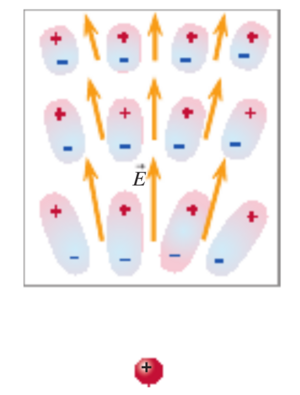Electric Dipole
An Electric Dipole is a pair of equal and opposite Point Charges separated by a small distance. Electric dipoles have a number of interesting properties.
claimed by Jmorton32 (talk) 02:52, 19 October 2015 (EDT)
Mathematical Models
An Exact Model

An electric dipole is constructed from two point charges, one at position [math]\displaystyle{ [\frac{d}{2}, 0] }[/math] and one at position [math]\displaystyle{ [\frac{-d}{2}, 0] }[/math]. These point charges are of equal and opposite charge. We then wish to know the electric field due to the dipole at some point [math]\displaystyle{ p }[/math] in the plane (see the figure). [math]\displaystyle{ p }[/math] can be considered either a distance [math]\displaystyle{ [x_0, y_0] }[/math] from the midpoint of the dipole, or a distance [math]\displaystyle{ r }[/math] and an angle [math]\displaystyle{ \theta }[/math] as in the diagram.
We state that the net electric field at [math]\displaystyle{ p }[/math] is [math]\displaystyle{ E_{net} }[/math] and has an x and y component, [math]\displaystyle{ E_{net_x} }[/math] and [math]\displaystyle{ E_{net_y} }[/math]. Then we can individually calculate the x and y components. First we realize that since [math]\displaystyle{ E_{net} = E_{q_+} + E_{q_-} }[/math], [math]\displaystyle{ E_{net_x} = E_{q_{+x}} + E_{q_{-x}} }[/math], similarly for y [math]\displaystyle{ E_{net_y} = E_{q_{+y}} + E_{q_{-y}} }[/math]. At this point, its worth noting that [math]\displaystyle{ E_{q_{+y}} = E_{q_+} * cos(\theta_+) }[/math], where [math]\displaystyle{ \theta_+ }[/math] is the angle from [math]\displaystyle{ q_{+} }[/math] to [math]\displaystyle{ p }[/math].
[math]\displaystyle{ \theta_+ }[/math] and its counterpart [math]\displaystyle{ \theta_- }[/math] are not known. However, we can calculate them. We know [math]\displaystyle{ \theta_+ }[/math] is formed by a triangle with one side length [math]\displaystyle{ p_y }[/math] and one side length [math]\displaystyle{ p_x - \frac{d}{2} }[/math]. Then [math]\displaystyle{ sin(\theta_+) = \frac{p_y}{\sqrt{(p_x - \frac{d}{2})^2+p_y^2}} }[/math], from which you can calculate the angle. This looks disgusting, but a close inspection shows that [math]\displaystyle{ p_y }[/math] is the opposite side of the triangle, and the denominator is an expression forming the hypotenuse of the triangle ([math]\displaystyle{ r_+ }[/math]) from known quantities. A similar method shows that [math]\displaystyle{ sin(\theta_-) = \frac{p_y}{\sqrt{(p_x + \frac{d}{2})^2+p_y^2}} }[/math], where once again [math]\displaystyle{ \sqrt{(p_x + \frac{d}{2})^2+p_y^2} = |\vec r_-| }[/math].
We now have values for [math]\displaystyle{ d, q, \theta_+, \theta_-, \vec r_+, \vec r_- }[/math]. This is enough to calculate [math]\displaystyle{ E_{net} }[/math] in both directions. The general formula for electric field strength from a Point Charge is [math]\displaystyle{ E = \frac{1}{4\pi\epsilon_0} \frac{q}{|\vec r|^2} \hat r }[/math]. Then [math]\displaystyle{ |E_+| = \frac{1}{4\pi\epsilon_0} \frac{q_+}{|\vec r_+|^2} }[/math] and [math]\displaystyle{ |E_-| = \frac{1}{4\pi\epsilon_0} \frac{q_-}{|\vec r_-|^2} }[/math]. We want solely the magnitude in this case because we can calculate direction and component forces using sin and cosine. Its worth noting that we can expand [math]\displaystyle{ r_+, r_- }[/math] to the form in the denominator of the sine and cosine. We will use this later.
First we calculate [math]\displaystyle{ E_{net_y} }[/math]. [math]\displaystyle{ E_{net_y} = E_{+_y} + E_{-_y} = \frac{1}{4\pi\epsilon_0} \frac{q_+}{|\vec r_+|^2} sin(\theta_+) + \frac{1}{4\pi\epsilon_0} \frac{q_-}{|\vec r_-|^2} sin(\theta_-) }[/math].
Then we combine some terms, noting that [math]\displaystyle{ q_+ = -q_- }[/math]. [math]\displaystyle{ E_{net_y} = \frac{q_+}{4\pi\epsilon_0} * \Bigg(\frac{1}{|\vec r_+|^2}sin(\theta_+) + \frac{-1}{|\vec r_-|^2}sin(\theta_-)\Bigg) }[/math]
Now it gets ugly, we expand our radii and sines. To recap, [math]\displaystyle{ sin(\theta_+) = \frac{p_y}{\sqrt{(p_x - \frac{d}{2})^2+p_y^2}} }[/math], [math]\displaystyle{ sin(\theta_-) = \frac{p_y}{\sqrt{(p_x + \frac{d}{2})^2+p_y^2}} }[/math], [math]\displaystyle{ |r_+| = \sqrt{(p_x - \frac{d}{2})^2 +p_y^2} }[/math] and [math]\displaystyle{ |r_-| = \sqrt{(p_x + \frac{d}{2})^2 +p_y^2} }[/math], giving us
[math]\displaystyle{ E_{net_y} = \frac{q_+}{4\pi\epsilon_0} * \Bigg( \frac{1}{ (p_x - \frac{d}{2})^2 +p_y^2 } \frac{p_y}{\sqrt{(p_x - \frac{d}{2})^2+p_y^2}} + \frac{-1}{ (p_x + \frac{d}{2})^2 +p_y^2 } \frac{p_y}{\sqrt{(p_x + \frac{d}{2})^2+p_y^2}} \Bigg) }[/math]
Finally we can combine more terms, the denominators of the expanded sines are the square roots of the radii. We can also pull out the negative sign.
[math]\displaystyle{ E_{net_y} = \frac{q_+}{4\pi\epsilon_0} \Bigg( \frac{p_y}{ \Big((p_x - \frac{d}{2})^2 +p_y^2 \Big)^\frac{3}{2} } - \frac{p_y}{ \Big((p_x + \frac{d}{2})^2 +p_y^2 \Big)^\frac{3}{2} } \Bigg) }[/math] That's as simplified as possible.
Much of the derivation for the x direction is similar. The major difference is that instead of calculating the sine, opposite over hypotenuse, we want cosine, adjacent over hypotenuse. That is, where [math]\displaystyle{ sin(\theta_+) = \frac{p_y}{\sqrt{(p_x - \frac{d}{2})^2+p_y^2}} }[/math], [math]\displaystyle{ cos(\theta_+) = \frac{p_x - \frac{d}{2}}{\sqrt{(p_x - \frac{d}{2})^2+p_y^2}} }[/math]. By using this and its counterpart for [math]\displaystyle{ \theta_- }[/math], the result is that
[math]\displaystyle{ E_{net_x} = \frac{q_+}{4\pi\epsilon_0} \Bigg( \frac{p_x - \frac{d}{2}}{ \Big((p_x - \frac{d}{2})^2 +p_y^2 \Big)^\frac{3}{2} } - \frac{p_x + \frac{d}{2}}{ \Big((p_x + \frac{d}{2})^2 +p_y^2 \Big)^\frac{3}{2} } \Bigg) }[/math]. These provide exact formulae for the electric field due to an electric dipole anywhere on the two-dimensional plane, and they translate easily into 3-dimensions.
Special Cases
On the Parallel Axis
On the Perpendicular Axis
An Approximate Solution
Examples
Be sure to show all steps in your solution and include diagrams whenever possible
Simple
Middling
Difficult
Connectedness
- How is this topic connected to something that you are interested in?
- How is it connected to your major?
- Is there an interesting industrial application?
History
Put this idea in historical context. Give the reader the Who, What, When, Where, and Why.
See also
Are there related topics or categories in this wiki resource for the curious reader to explore? How does this topic fit into that context?
Further reading
Books, Articles or other print media on this topic
External links
Internet resources on this topic
References
This section contains the the references you used while writing this page